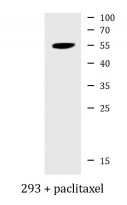ARG66846
anti-TRF1 phospho (Ser219) antibody
anti-TRF1 phospho (Ser219) antibody for Western blot and Human
Overview
| Product Description | Rabbit Polyclonal antibody recognizes TRF1 phospho (Ser219) |
|---|---|
| Tested Reactivity | Hu |
| Predict Reactivity | Ms |
| Tested Application | WB |
| Specificity | This antibody detects endogenous levels of TRF1 protein only when phosphorylated at Ser219. |
| Host | Rabbit |
| Clonality | Polyclonal |
| Isotype | IgG |
| Target Name | TRF1 |
| Antigen Species | Human |
| Immunogen | Phosphospecific peptide around Ser219 (aa. 185-234) of Human TRF1. |
| Conjugation | Un-conjugated |
| Alternate Names | Telomeric repeat-binding factor 1; NIMA-interacting protein 2; t-TRF1; TRF; TRF1; TRBF1; hTRF1-AS; TTAGGG repeat-binding factor 1; PIN2; Telomeric protein Pin2/TRF1 |
Application Instructions
| Application Suggestion |
|
||||
|---|---|---|---|---|---|
| Application Note | * The dilutions indicate recommended starting dilutions and the optimal dilutions or concentrations should be determined by the scientist. | ||||
| Positive Control | 293 + paclitaxel | ||||
| Observed Size | ~ 55 kDa |
Properties
| Form | Liquid |
|---|---|
| Purification | Affinity purification with immunogen. |
| Buffer | PBS, 0.02% Sodium azide, 50% Glycerol and 0.5% BSA. |
| Preservative | 0.02% Sodium azide |
| Stabilizer | 50% Glycerol and 0.5% BSA |
| Concentration | 1 mg/ml |
| Storage Instruction | For continuous use, store undiluted antibody at 2-8°C for up to a week. For long-term storage, aliquot and store at -20°C. Storage in frost free freezers is not recommended. Avoid repeated freeze/thaw cycles. Suggest spin the vial prior to opening. The antibody solution should be gently mixed before use. |
| Note | For laboratory research only, not for drug, diagnostic or other use. |
Bioinformation
| Database Links | |
|---|---|
| Gene Symbol | TERF1 |
| Gene Full Name | telomeric repeat binding factor (NIMA-interacting) 1 |
| Background | This gene encodes a telomere specific protein which is a component of the telomere nucleoprotein complex. This protein is present at telomeres throughout the cell cycle and functions as an inhibitor of telomerase, acting in cis to limit the elongation of individual chromosome ends. The protein structure contains a C-terminal Myb motif, a dimerization domain near its N-terminus and an acidic N-terminus. Two transcripts of this gene are alternatively spliced products. [provided by RefSeq, Jul 2008] |
| Function | Binds the telomeric double-stranded 5'-TTAGGG-3' repeat and negatively regulates telomere length. Involved in the regulation of the mitotic spindle. Component of the shelterin complex (telosome) that is involved in the regulation of telomere length and protection. Shelterin associates with arrays of double-stranded 5'-TTAGGG-3' repeats added by telomerase and protects chromosome ends; without its protective activity, telomeres are no longer hidden from the DNA damage surveillance and chromosome ends are inappropriately processed by DNA repair pathways. [UniProt] |
| Cellular Localization | Nucleus. Cytoplasm, cytoskeleton, spindle. Chromosome, telomere. Note=Colocalizes with telomeric DNA in interphase and prophase cells. Telomeric localization decreases in metaphase, anaphase and telophase. Associates with the mitotic spindle. [UniProt] |
| Calculated MW | 50 kDa |
| PTM | Phosphorylated preferentially on Ser-219 in an ATM-dependent manner in response to ionizing DNA damage. ADP-ribosylation by TNKS1 or TNKS2 diminishes its ability to bind to telomeric DNA. Ubiquitinated by RLIM/RNF12, leading to its degradation by the proteasome. Ubiquitinated by a SCF (SKP1-CUL1-F-box protein) ubiquitin-protein ligase complex, leading to its degradation by the proteasome. [UniProt] |
Images (1) Click the Picture to Zoom In






